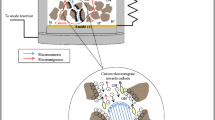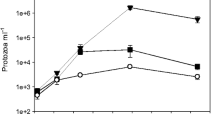Abstract
There has been increasing interest in employing electro-bioremediation, a hybrid technology of bioremediation and electrokinetics, to overcome the low bioavailability of hydrophobic organic contaminants (HOC) by homogenizing sorption-retarded HOC and immobilised microorganisms. Present electro-remediation approaches mainly aim at macroscale pollutant extraction and tend to neglect possible impacts of direct current (DC) on the physiology of microorganisms. The effect of weak electric fields (X = 1 V cm−1) on the fitness of electrokinetically dispersed fluorene-degrading Sphingomonas sp. LB126 in bench-scale model aquifers was investigated by flow cytometry using propidium iodide (PI) as an indicator that distinguishes between PI-permeable (cells with porous membranes, i.e. dead or vulnerable) and PI-impermeable bacteria. After 15.5 h of DC treatment 56% of all cells recovered were dispersed at the centimetre scale relative to 29% in the absence of DC. There was no overall negative effect of the 15.5-h DC treatment on cell vulnerability, as 7.0% of the DC-treated bacteria exhibited PI-staining compared to 6.5% of the control population. Minor differences were observed in the subpopulation that had been mobilised by electroosmosis with an approximately twofold increase in the percentage of PI-stained cells relative to the control. Enhanced PI staining did not correlate with reduced culturability of the cells on rich-medium agar plates. Relative to the control, DC-treated cells mobilised by electroosmosis were threefold more culturable, confirming earlier data that that PI-cell membrane permeability does not always indicate reduced viability of oligotrophic environmental bacteria. Our findings suggest that electrokinetics is a valuable mechanism to transport viable and culturable polycyclic aromatic hydrocarbon (PAH)-degrading bacteria in soil or sediments.



Similar content being viewed by others
References
Bastiaens, L., Springael, D., Wattiau, P., Harms, H., de Wachter, R., Verachtert, H., & Diels, L. (2000). Isolation of adherent polycyclic aromatic hydrocarbon (PAH) degrading bacteria using PAH sorbing carriers. Applied and Environmental Microbiology, 66, 1834–1843.
Chen, C. Y., Nace, G. W., & Irwin, P. L. (2003). A 6 × 6 drop plate method for simultaneous colony counting and MPN enumeration of Campylobacter jejuni, Listeria monocytogenes, and Escherichia coli. Journal of Microbiological Methods, 55, 475–479.
DeFlaun, M. F., & Condee, C. W. (1997). Electrokinetic transport of bacteria. Journal of Hazardous Materials, 55, 263–277.
Guillou, S., Besnard, V., Murr, N. E., & Federighi, M. (2003). Viability of Saccharomyces cerevisiae cells exposed to low-amperage electrolysis as assessed by staining procedure and ATP content. International Journal of Food Microbiology, 88, 85–89.
Harms, H., & Wick, L. Y. (2006). Dispersing pollutant-degrading bacteria in contaminated soil without touching it. Engineering in Life Sciences, 6, 252–260.
Harms, H., & Zehnder, A. J. B. (1994). Influence of substrate diffusion on degradation of dibenzofuran and 3-chlorodibenzofuran by attached and suspended bacteria. Applied and Environmental Microbiology, 60, 2736–2745.
Hayes, A. M., Flora, J. R. V., & Khan, J. (1998). Electrolytic stimulation of denitrification in sand columns. Water Research, 32, 2830–2834.
Jackman, S. A., Maini, G., Sharman, A. K., & Knowles, C. J. (1999). The effects of direct current on the viability and metabolism of acidophilic bacteria. Enzyme and Microbial Technology, 24, 316–324.
Johnsen, A. R., Wick, L. Y., & Harms, H. (2005). Principles of microbial PAH-degradation in soil. Environmental Pollution, 133(1), 71–84.
Lear, G., Harbottle, M. J., Sills, G., Knowles, C. J., Semple, K. T., & Thompson, I. P. (2007). Impact of electrokinetic remediation on soil communities within PCP contaminated soil. Environmental Pollution, 146, 139–146.
Lear, G., Harbottle, M. J., van der Gast, C. J., Jackman, S. A., Knowles, C. J., Sills, G., & Thompson, I. P. (2005). The effect of electrokinetics on soil microbial communities. Soil Biology & Biochemistry, 36, 1751–1760.
Luo, Q., Zhang, X., Wang, H., & Qian, Y. (2005). The use of non-uniform electrokinetics to enhance in situ bioremediation of phenol-contaminated soil. Journal of Hazardous Materials, B121, 187–194.
Pribyl, M., Chmelikova, R., Hasal, P., & Marek, M. (2001). Modeling of hydrogel immobilized enzyme reactors with mass-transport enhancement by electric field. Chemical Engineering Science, 56, 433–442.
Shi, L., Günther, S., Hübschmann, T., Wick, L. Y., Harms, H., & Müller, S. (2007). Limits of propidium iodide (PI) as a cell viability indicator for environmental bacteria. Cytometry A, 71A(1), 592–598.
Shi, L., Müller, S., Loffhagen, N., Harms, H., & Wick, L. Y. (2008). Activity and viability of polycyclic aromatic hydrocarbon-degrading Sphingomonas sp. LB126 in a DC-electrical field typical for electrobioremediation measures. Microbial Biotechnology, 1, 53–61.
Suni, S., & Romantschuk, M. (2004). Mobilisation of bacteria in soils by electro-osmosis. FEMS Microbiology Ecology, 49, 51–57.
Velizarov, S. (1999). Electric and magnetic fields in microbial biotechnology: Possibilities, limitations and perspectives. Electro- and Magnetobiology, 18, 185–212.
van Herwijnen, R., Wattiau, P., Bastiaens, L., Daal, L., Jonker, L., Springael, D., et al. (2003). Elucidation of the metabolic pathway of fluorine and cometabolic pathways of phenanthrene, fluoranthene, anthracene and dibenzothiophene by Sphingomonas sp LB126. Research in Microbiology, 154, 199–206.
Vogt, C., Lösche, A., Kleinsteuber, S., & Müller, S. (2005). Population profiles of a binary bacterial culture grown with toluene under sulphate reducing conditions. Cytometry, 66A, 91–102.
Wick, L. Y., Mattle, P. M., Wattiau, P., & Harms, H. (2004). Electrokinetic transport of PAH-degrading bacteria in model aquifers and soil. Environmental Science and Technology, 38, 4596–4602.
Wick, L. Y., Shi, L., & Harms, H. (2007). Electrobioremediation of hydrophobic organic soil contaminants: A review of fundamental interactions. Electrochimica Acta, 52, 3441–3448.
Zimmermann, U., Schulz, J., & Pilwat, G. (1974). Dielectric breakdown of cell membranes. Biophysical Journal, 14, 881–899.
Acknowledgements
The authors wish to thank J. Reichenbach, R. Remer, B. Würz, and H. Engewald for skilled technical help.
Author information
Authors and Affiliations
Corresponding author
Rights and permissions
About this article
Cite this article
Shi, L., Müller, S., Harms, H. et al. Effect of electrokinetic transport on the vulnerability of PAH-degrading bacteria in a model aquifer. Environ Geochem Health 30, 177–182 (2008). https://doi.org/10.1007/s10653-008-9146-0
Received:
Accepted:
Published:
Issue Date:
DOI: https://doi.org/10.1007/s10653-008-9146-0




